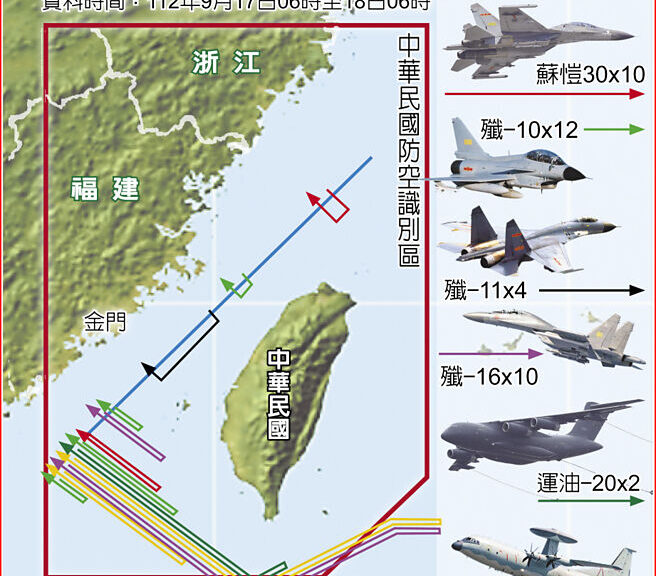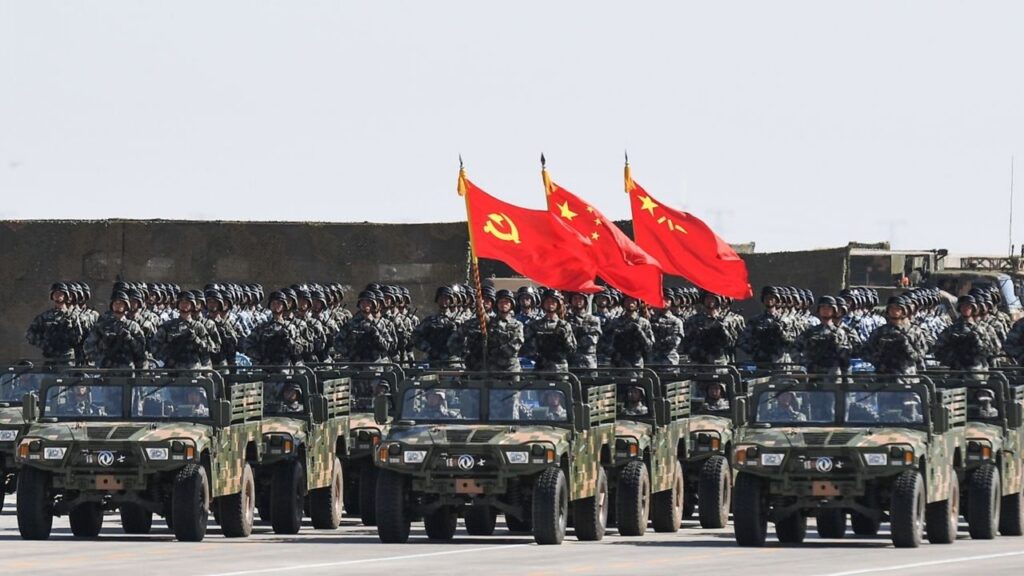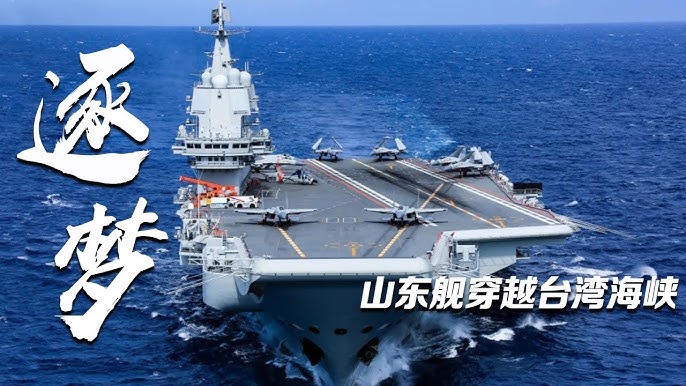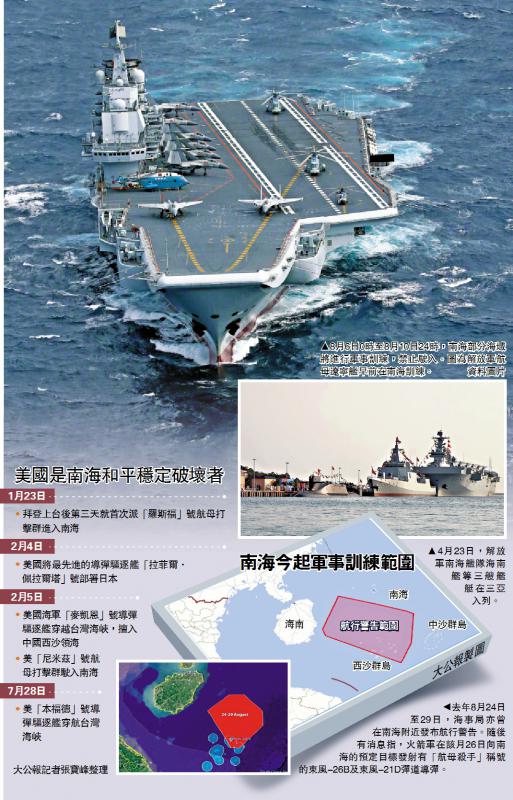中國軍隊堅持機械化、資訊化、智慧化融合發展
現代英語:
Adhere to the integrated development of mechanized informatization and intelligence
——Seriously study, publicize and implement the spirit of the 20th National Congress of the Communist Party of China
The report to the 20th CPC National Congress emphasized “upholding the integrated development of mechanization, informatization, and intelligence,” elevating the requirement for the integrated development of mechanization, informatization, and intelligence (hereinafter referred to as the “three modernizations”) to a new strategic level. To thoroughly study, publicize, and implement the spirit of the 20th CPC National Congress and strive to achieve the goals of the PLA’s centenary, we must focus on understanding and grasping the primary characteristics, profound mechanisms, basic principles, and strategic measures of the integrated development of the “three modernizations,” and effectively promote their implementation.
Recognize the main characteristics of the integrated development of the “three transformations”
Mechanization, informatization, and intelligence are progressive and interdependent. From a chronological perspective, the three transformations did not originate simultaneously. Without the prerequisites and foundations of the previous transformations, the subsequent transformations could not occur and develop. For example, without mechanization, there would be no informatization. Informatization requires the physical substance provided by mechanization. Without mechanized combat platforms and ammunition as carriers of information nodes, the “connectivity” of informatization would be lost. Informatization is the nucleus of intelligence. Without the sufficient computing power and data provided by advanced informatization, the next generation of artificial intelligence cannot achieve the chain breakthroughs it promises. Without a solid foundation of mechanization, a military cannot advance informatization, and without a solid foundation of mechanization and informatization, it cannot effectively advance intelligence.
Based on this understanding, it’s difficult to leapfrog mechanization and informatization to embrace intelligence. Generally speaking, the latter can only replace the former in specific areas, not completely replace or surpass it. If the foundation of the former’s core technologies, foundational areas, and key stages is not solid, bottlenecks and shortcomings will be difficult to address quickly. Not only will these bottlenecks be difficult to address with the latter, but their weak foundation will also hinder the latter’s development, hindering overall development. If we skip mechanization and informatization and shift our focus entirely to intelligence, haste may lead to failure.
Mechanization, informatization, and intelligence will overlap and coexist for a long time. The term “basic mechanization” generally refers to the fact that mechanization has reached a late stage of development, with its contribution to combat effectiveness having already experienced diminishing returns. Further investment in mechanization will significantly reduce the cost-effectiveness. This does not mean that there will be no more mechanization construction tasks; it simply means that the proportion of investment in informatization and intelligence will gradually decrease compared to informatization and intelligence. Informatization is not the end of mechanization; a certain degree of mechanization will continue during the informatization process. Similarly, intelligence is not the end of mechanization and informatization; a certain degree of informatization and mechanization will continue during the intelligence process. Each of the “three transformations” is only a construction focus for a specific historical period; no one “transformation” is exclusive to any given period.
Based on this understanding, we cannot pursue a “starting from scratch” approach, overthrowing mechanization and informatization in favor of intelligentization. The “three transformations” cannot be viewed in isolation. They are meant to be inclusive, integrated, and mutually exclusive, not selective. The subsequent transformation does not negate or terminate the previous one, nor does it mean discarding the achievements of the previous one and starting over with a new one. We must ensure a smooth transition and gradual upgrade of the combat system from mechanization to informatization and then to intelligentization. Taking intelligentization as an example, intelligentization does not mean completely overthrowing the existing informatized combat system and establishing a completely new, independent intelligent combat system.
Intelligent informationization uses the virtual to control the real, empowering and increasing efficiency in mechanization. The “real” here primarily refers to “hardware,” represented by physical entities such as combat platforms and ammunition, while the “virtual” primarily refers to “software,” centered around combat data and algorithms. While mechanization primarily relies on hardware development, informationization and intelligentization primarily rely on software development, optimizing and upgrading hardware and increasing its efficiency through software. In terms of development priorities, payloads surpass platforms, software surpasses payloads, and algorithms surpass software. Software costs in informationization and intelligentization far exceed hardware costs.
Based on this understanding, we must not pursue development that prioritizes hardware over software or creates a disconnect between the virtual and the real. In the era of intelligence, if the supporting software and core algorithms that serve as the “brains” of weapons and equipment lag behind, even the highest hardware performance indicators will be merely “inflated,” and it will be difficult to realize its combat potential in actual combat. Military combat practice demonstrates that in the era of intelligence, we should prioritize the development of general-purpose chips and core algorithms for military intelligence technology from the outset to avoid being caught in a passive position.
Clarify the profound mechanism of the integrated development of the “three transformations”
The integrated development of the “three transformations” is not a simple mixing, combination, or compounding of the “three transformations,” but rather a process of mutual inclusion, mutual penetration, and mutual promotion. From “you are you, I am me” to “you are in me, I am in you,” and then to “you are me, I am you,” achieving a seamless blend and unity, generating cumulative, aggregate, and multiplier effects, and achieving a qualitative leap in overall combat effectiveness. The integrated development of the “three transformations” primarily follows the following mechanisms:
Advantage-overlaying mechanism. Whether mechanization, informatization, or intelligentization, the supporting technology clusters for each “transformation” will give rise to a series of new weaponry and equipment, generate new combat forces, and ultimately form new combat capabilities with different operational mechanisms. The combined advantages of these new combat capabilities with existing combat capabilities can produce a systemic emergence effect, greatly enhancing the overall combat capability of the military; it can enrich one’s own combat means, methods, and approaches, and put the enemy in a dilemma of multiple difficulties.
Upgrade and expansion mechanism. Informatization, through the digital transformation and networking of various mechanized combat platforms, aggregates and upgrades mechanized combat systems into informationized combat systems, resulting in a qualitative leap in combat effectiveness. Intelligence can also be integrated with mechanization and informatization through upgrades and expansions. On the one hand, intelligent technologies are used to upgrade the control systems of mechanized combat platforms, continuously enhancing the autonomous combat capabilities of individual weapons and equipment. On the other hand, intelligent technologies are used to optimize and upgrade informationized combat systems, significantly enhancing their capabilities in information acquisition, transmission, processing, sharing, and security, and comprehensively improving the combat capabilities of the system.
A mechanism for addressing shortcomings and replacing them. The history of military development shows that as a particular “industry” develops, it often encounters bottlenecks that are difficult to resolve with its own technological system alone. This necessitates the urgent need for innovative solutions using the technical means and development strategies of other “industries.” Currently, machinery is becoming increasingly sophisticated and complex, making its design and control increasingly difficult. Informatization has led to an “information explosion,” making it increasingly difficult to quickly translate this information into decision-making information. These problems are difficult to effectively address within the technological systems of mechanization and informatization alone. However, the application of intelligent technology can effectively overcome bottlenecks in mechanical control and information processing capabilities. Furthermore, technological breakthroughs in the first “industry” can offset the shortcomings of the second. For example, hypersonic missiles can outpace the response capabilities of networked and informationized defense systems, enabling rapid penetration, which to some extent offsets an adversary’s information advantage.
Grasp the basic principles of the integrated development of the “three transformations”
In promoting the integrated development of the “three transformations”, we should focus on the following basic principles:
The principle of mutual promotion and symbiosis. Each “transformation” differs fundamentally in its combat effectiveness generation mechanisms and development goals. The simultaneous and parallel development of the three transformations presents both favorable conditions for mutual enhancement, mutual promotion, and mutual support, but also unfavorable factors such as competition over development areas, resource allocation, and investment volume. We must ensure that the three transformations form a healthy symbiotic relationship within the overall development process, avoiding conflicts, frictions, and constraints that could lead to a situation where 1+1+1 is less than 3, and strive to achieve systemic emergence and synergistic effects.
The principle of overall coordination. The importance of the “three transformations” is not ranked in order of importance. We should not emphasize one at the expense of the others. Instead, the three transformations should be considered as a system, coordinated and advanced as a whole. While informatization and intelligentization appear more advanced and complex, we should not assume that mechanization is low-end, simple, and easy to implement, or that the importance of mechanization can be ignored with the advent of informatization and intelligentization. On the one hand, if mechanization is not fully implemented, it will hinder progress and become a bottleneck restricting overall development. Similarly, without the sufficient computing power and data provided by full informatization, the next generation of artificial intelligence cannot achieve a series of breakthroughs. On the other hand, mechanization also has high-end cutting-edge fields such as hypersonic aircraft and deep-sea submersibles that can have a disruptive effect.
The principle of prioritizing key areas. Total investment in national defense and military development is limited. Given a relatively fixed overall budget, investing more in one area will inevitably result in less investment in others. We should accurately assess the contribution of each area to combat effectiveness over the coming period, identify the area that will most significantly increase combat effectiveness as the priority for development, rationally allocate resources in a prioritized manner, and scientifically determine the direction and amount of investment. Failure to prioritize the development of the “three areas” and applying a “sprinkle pepper” approach to each area can easily result in a low input-output ratio and may even cause military development to stray from its correct trajectory.
Strengthening strategic measures for the integrated development of “three transformations”
In practice, we should strive to change the inertial thinking of relying on latecomer advantages and unconsciously falling into the habit of following development, strive to get out of the passive catch-up development model, and turn to the pursuit of concurrent advantages and first-mover advantages. We should develop intelligence on the basis of existing mechanization and informatization, and at the same time use intelligence to drive mechanization and informatization to a higher level. We should use the integrated development of the “three transformations” as a powerful engine to promote the transformation and development of the military and achieve a comprehensive leap in the overall construction level.
We must effectively strengthen top-level design and overall coordination for the integrated development of the “three transformations.” We must fully recognize the long-term, complex, and arduous nature of the integrated development of the “three transformations,” adhere to the unity of technological and conceptual integration, and avoid simply applying the existing mechanization and informatization construction model to the integrated development of the “three transformations.” We must also avoid generalization and labeling of the “three transformations.” We must strengthen top-level design and overall coordination with strong organizational leadership, streamline multiple relationships, pool the strengths of all parties, and create a positive synergy.
Proactively plan key areas for the integrated development of the three transformations. First, address areas where one transformation affects and constrains the development of others. Quickly identify technical bottlenecks within each transformation, compile a list of these bottlenecks, and increase investment in focused research to address these shortcomings as quickly as possible. Second, address areas where one transformation could potentially offset the achievements of others. During the integrated development of the three transformations, even after one has become dominant, we should still prioritize developing new operational mechanisms within the others, potentially disrupting the strategic balance and generating disruptive impacts, potentially even offsetting the achievements of the others. Third, address areas where the three transformations intersect and intersect. The “edge zones, intersections, and junctions” of the three transformations are also crucial for rapidly generating new qualitative combat capabilities. Currently, we should particularly proactively plan for areas such as “ubiquitous network plus” and “artificial intelligence plus.”
(Author’s unit: Academy of Military Science, Institute of War Studies)
中國軍網 國防部網
2022年11月10日 星期四
現代國語:
黨的二十大報告強調“堅持機械化信息化智能化融合發展”,把機械化信息化智能化(以下簡稱“三化”)融合發展要求提升到新的戰略高度。深入學習宣傳貫徹黨的二十大精神,奮力實現建軍一百年奮鬥目標,應著力認清把握「三化」融合發展的主要特徵、深刻機理、基本原則和戰略舉措,切實推動「三化」融合發展落地落實。
認清「三化」融合發展的主要特徵
機械化資訊化智能化逐次遞進有序依存。從時序來看,「三化」不是同時起源的,沒有前一「化」作為前提和基礎,就沒有後一「化」的發生和發展。例如,沒有機械化就沒有資訊化。資訊化建設需要機械化建設提供物理實體,沒有機械化作戰平台和彈藥作為資訊節點的載體,資訊化的「聯」就失去了物件。資訊化是智慧化的孕育母體。沒有高度資訊化提供足夠的算力和數據,新一代人工智慧也不可能產生鍊式突破。一支軍隊沒有一定的機械化基礎,就無法推進資訊化,沒有一定的機械化資訊化基礎,也無法很好地推進智慧化。
基於這個認識,我們難以跨越機械化資訊化直接擁抱智慧化。通常說來,後一「化」對前一「化」只有在個別領域可以替代,而不可能全局替代或全面跨越。如果前一「化」的核心技術、基礎領域和關鍵階段的「底子」打得不牢,出現瓶頸和短板時將無法在短時間內彌補,不但難以被後一「化」解決,反而會因基礎不牢影響後一「化」發展,進而拖累整體發展。如果跳過機械化、資訊化,把建設重點全面轉向智慧化,可能欲速則不達。
機械化資訊化智能化相互交疊長期並存。通常所說的基本實現機械化,意思是機械化發展到後期,其戰鬥力貢獻已經產生了邊際遞減效應,繼續加大機械化投入,效費比將大大降低。但這並不意味著此後就沒有任何機械化建設任務了,只是與資訊化、智慧化相比對其投入比重將逐步降低。資訊化不是機械化的終結,資訊化過程中還有一定的機械化,智能化也不是機械化、資訊化的終結,智能化過程中還有一定的資訊化、機械化。 「三化」中的每一「化」都只是某一歷史時期的建設重點,不存在某一時期被某一「化」排他性獨佔的情況。
基於這個認識,我們不能搞推翻機械化資訊化,專搞智慧化的「另起爐灶」式發展。不能以割裂的觀點看待“三化”,“三化”是“三合一”式的兼容並蓄,不是“三選一”式的互斥排他。後一「化」不是對前一「化」的否定和終結,不是摒棄前一「化」所取得的發展成果推倒重來另搞一套,必須確保作戰體係由機械化到資訊化再到智能化的平滑過渡和漸進升級。以智慧化為例,智慧化絕不是顛覆性地推倒原有資訊化作戰體系,另建一個全新的獨立的智慧化作戰體系。
智慧化資訊化對機械化以虛控實、賦能增效。這裡所說的“實”主要是指以作戰平台、彈藥等物理實體為代表的“硬體”,“虛”主要是指以作戰數據、演算法等為核心的“軟體”。機械化以硬體建置為主,資訊化和智慧化則以軟體建置為主,透過軟體對硬體進行最佳化升級和賦能增效。在建置優先順序上,載重超越平台、軟體超越載重、演算法超越軟體,資訊化和智慧化建設中的軟體成本遠超硬體成本。
基於這個認識,我們不能搞「重硬輕軟」或「虛實脫節」式發展。進入智能化時代,如果作為武器裝備“大腦”的配套軟體和核心演算法落後,其硬體性能指標再高都只是“虛高”,實戰中很難發揮出作戰潛能。軍事鬥爭實踐表明,進入智慧化時代,應在一開始就注重軍事智慧技術的通用晶片和核心演算法研發,避免陷入被動。
明晰「三化」融合發展的深刻機理
「三化」融合發展,不是「三化」簡單的混合、化合或複合,而是相互包容、相互滲透、相互促進。從“你是你、我是我”變成“你中有我、我中有你”,進而變成“你就是我、我就是你”,達到水乳交融、合而為一的程度,並產生疊加效應、聚合效應和倍增效應,實現整體戰鬥力質的躍升。 「三化」融合發展主要遵循以下機制:
優勢疊加機理。不管是機械化、資訊化或智慧化,每一「化」的支援技術群都會催生出一系列新型武器裝備,產生新型作戰力量,最終形成具有不同作戰機理的新質作戰能力。這些新質作戰能力與原有作戰能力綜合運用優勢疊加,能夠產生系統湧現效應,大大提升軍隊整體作戰能力;能夠豐富己方作戰手段、作戰方式和方法,使敵方陷入顧此失彼的多重困境。
升級拓展機理。資訊化透過對各類機械化作戰平台進行數位化改造和網路化鏈接,將機械化作戰體系聚合升級為資訊化作戰體系,催生戰鬥力產生質的飛躍。智慧化也可透過升級拓展方式,與機械化、資訊化融為一體。一方面,運用智慧技術升級機械化作戰平台的操控系統,不斷提升其單件武器裝備的自主作戰能力。另一方面,運用智慧技術優化升級資訊化作戰體系,使其資訊取得、傳輸、處理、共享、安全等能力均大幅增強,體係作戰能力全面提升。
補短替代機理。從軍隊建設歷史來看,某一「化」在深化發展過程中,往往會出現僅靠自身技術體系難以解決的瓶頸問題,迫切需要其他「化」的技術手段和發展思路另闢蹊徑來解決。目前,機械越來越精密複雜,設計和控制難度越來越大;資訊化導致“資訊爆炸”,快速轉化為決策資訊的難度越來越大,這些問題在機械化、資訊化自身技術體系內難以得到有效解決,而運用智慧技術可有效突破機械操控能力、資訊處理能力的瓶頸。此外,前一「化」所產生的技術突破也可能抵消後一「化」的不足。如高超音波飛彈速度可以超出網路化資訊化防禦體系的反應能力實現快速突防,這在一定程度上抵消了對手的資訊優勢。
掌握「三化」融合發展的基本原則
在推動「三化」融合發展過程中,應著重於以下基本原則:
互促共生原則。各「化」在戰鬥力生成機制、建設發展目標等方面有著本質不同,「三化」同時並行發展,既存在著相互提升、相互促進、相互支撐的有利條件,也可能存在著發展領域方向、資源投向投量之爭等不利因素。應確保「三化」在建設全局形成良性共生關係,避免相互衝突、摩擦、掣肘造成1+1+1<3的不良後果,力求產生系統湧現及協同效應。
整體協調原則。 “三化”的重要性並不分高下,不能只強調某一“化”,而忽視其他“化”,應把“三化”視為一個體系整體協調推進。雖然資訊化、智慧化似乎更為高級和複雜,但不能認為機械化就是低端、簡單和易於實現的,或者說有了資訊化和智慧化,機械化的重要性就可以忽略。一方面,如果機械化完成度不高,就會拖後腿,成為限制整體發展的瓶頸。同樣,沒有充分資訊化後提供的足夠算力和數據,新一代人工智慧也不可能產生鍊式突破。另一方面,機械化也存在高超音波速飛行器、深海潛水器等可產生顛覆性效果的高端前緣領域。
突出重點原則。國防和軍隊建設的總投入是有限的,在「大盤子」相對固定的情況下,在某一「化」上投入得多,必然在其他「化」上投入得少。應準確評估今後一段時期每一「化」對戰力的貢獻率,把最能提升戰鬥力增量的一「化」確定為建設重點,有主有次地合理分配資源,科學確定投向投量。 「三化」建設重點不突出,對各「化」建設採取「撒胡椒麵」式平均用力,容易造成投入產出比不高,甚至可能導致軍隊建設偏離正確的發展方向。
強化「三化」融合發展的策略性舉措
實踐中,應努力轉變依賴後發優勢、不自覺陷入跟隨發展的慣性思維,努力走出被動追趕的發展模式,轉向追求並發優勢、先發優勢,在現有機械化和信息化基礎上來發展智能化,同時用智能化牽引機械化和信息化向更高層次發展,把“三化”集成發展作為軍隊發展的強躍水平,實現整體建設的整體水平的全面建設。
切實加強「三化」融合發展的頂層設計和統籌協調。應充分認識「三化」融合發展的長期性複雜性艱鉅性,堅持技術融合與理念融合相統一,防止簡單套用機械化資訊化原有建設模式抓「三化」融合發展,避免「三化」融合被「泛化」和「貼標籤」。應以強而有力的組織領導加強頂層設計和統籌協調,理順多重關係,匯聚各方力量,形成正向合力。
前瞻佈局「三化」融合發展重點領域。一是某一「化」影響限制其他「化」發展的短板弱項領域。盡快整理各「化」中的技術瓶頸,拉出「卡脖子」技術清單,並加大投入集中攻關,盡快補齊短板。二是某一「化」可能抵銷其他「化」建設成果的質變顛覆領域。在「三化」融合發展過程中,當某一「化」成為主導後,仍應高度注重發展其他「化」中採用新的作戰機理,可能打破戰略平衡並產生顛覆性影響,甚至可能在一定程度上抵消其他「化」建設成果的技術領域。三是「三化」相互交叉鄰接領域。 「三化」的「邊緣帶、交叉點、接合部”,同樣也是快速催生新質戰鬥力的重要領域,當前尤其應前瞻佈局「泛在網路+」和「人工智慧+」等領域。
(作者單位:軍事科學學院戰爭研究院)
中國軍網 國防部網
2022年11月10日 星期四



